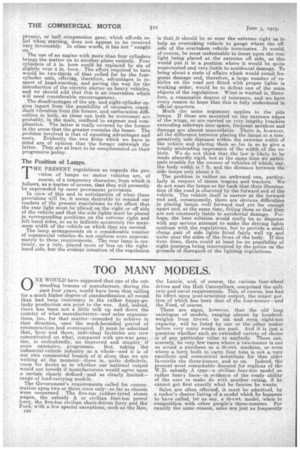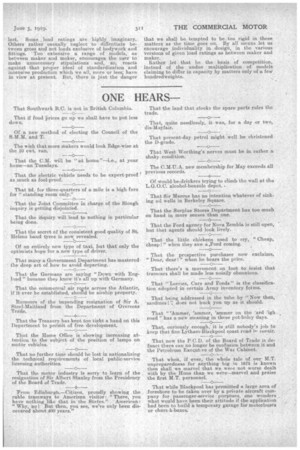TOO MANY MODELS.
Page 2

Page 3

If you've noticed an error in this article please click here to report it so we can fix it.
0 NE WOULD have supposed that one of the outstanding lessons of manufacture, during the past four years, would have been that calling for a much higher degree of standardization all round than had been customary in the rather happy-golucky production era prior to the war. And, indeed, there has been not a little talk up and down the country of what manufacturers—and sales organizations, too, for that matter—intended to achieve in that direction, once the much-heralded period of reconstruction had eventuated. It must be admitted that, here and there, individual factories are now concentrated on what, compared with pre-war practice, is undoubtedly, an improved and simpler, if more extensive, programme. But, taking the industrial-vehicle industry as a whole—and it is of our own commercial branch of it alone that we are writing at the moment--there is, quite definitely, room for doubt as to whether our -national output would not benefit if manufacturers would agree upon a certain clearly defined—and as clearly limited—
range of load-carrying models. .
The Government's requirements called for concentration upon two or three sizes only—so far as chassis were concerned. The five-ton rubber-tyred steans wagon, the subsidy A or civilian four-ton petrol lorry, the five-ton civilian chain-driven lorry and the Ford, with a few special exceptions, such as the Reo, e24 the Lancia; and, of course, the various four-wheel drives and the Holt Caterpillars, comprised the military and naval requirements. This, of course, has had its effect upon post-armistice output, the major portion of which has been that of the four-termer—and the Ford, of course. There are signs, however, that the old long catalogue of models, ranging almost by . hundredweights from 15-cwt. to six and even eight-ton capacity, will be listed by one or the other maker blefore very many weeks are past. And it is just a question whether such an extended variety of choice is of any particular value to anybody. There can, scarcely, be very few cases where a two-tonner is not as sound a purchase as a 30-cwt. machine, or even where a lorry built to carry four tons is not a very excellent and economical substitute for that older favourite the three-tonner, and so on. Indeed, the present most remarkable demand for replicas of the W.D. subsidy A type—a civilian four-ton model on rather heavy lines—is evidence of the ready ability of the user to make do with another rating, if he cannot get first exactly what he fancies he wants.
• Sales are often effected, it must be admitted, by a maker's chance listing of a model which he happens to have called, let us say, a 45-cwt. model, when in competition with other people's three-tonners. For exactly the same reason, sales are just as frequently lost. Some load ratings .are highly. imaginary. Others rather casually neglect to diffentiate between gross and net loads exclusive of bodywork and fittings. Too extensive a range of models, as between maker and maker, encourages. the: User to make unnecessary stipulations and, so, reacts against that proper ideal of standardization and intensive production which we all, more or less, have in view at preSent. But, there is just the danger that we shall be tempted to be .too rigid in these matters as the time goes on. By all means let us encourage individuality in design, in the various versions of given load ratings as between maker and maker.
Rather let that be the basis of competition, instead of the undue multiplication of models claiming to differ in capacity by matters only of a few hundredweights.






















